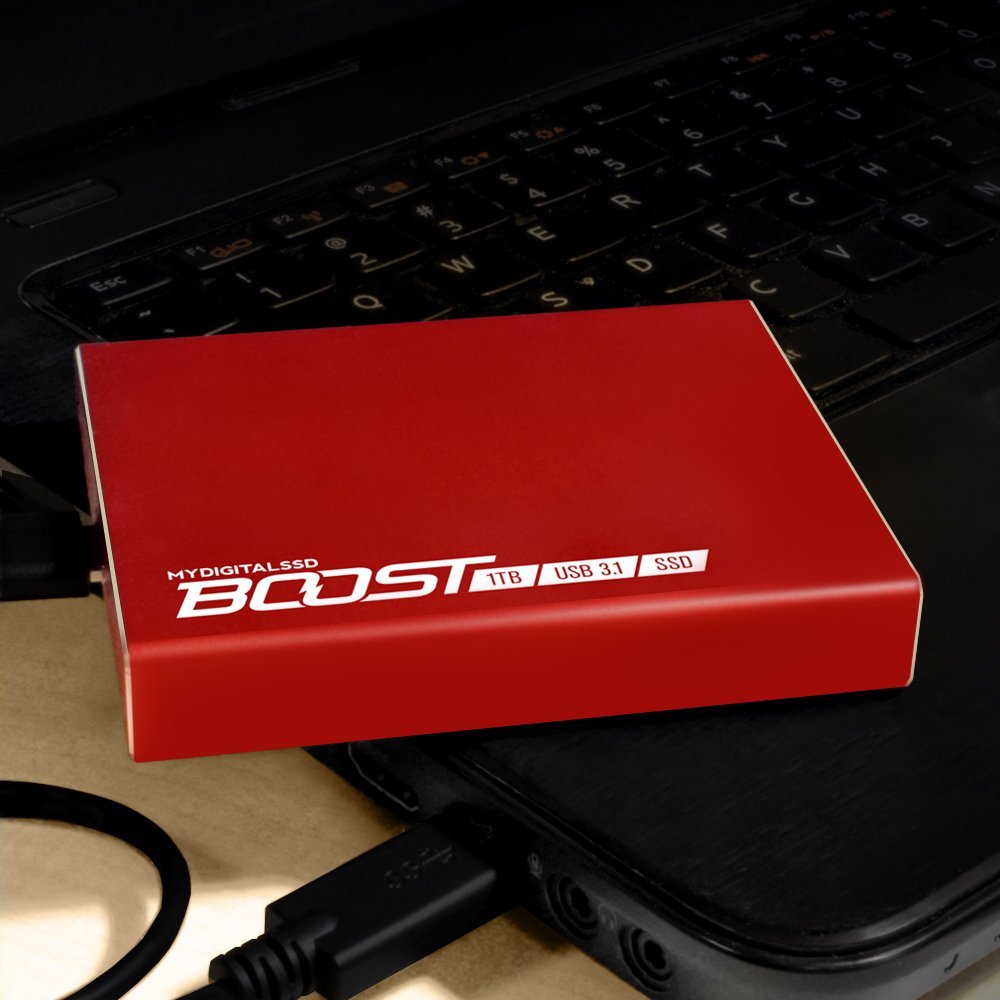Early Verdict
The MyDigitalSSD Boost is the fastest portable SSD we've tested to date. The drive uses off-the-shelf components in a brilliant way to deliver the best experience. We really like the option to use Samsung flash or the DIY model so you can roll your own. The 1TB model offers superior value and is the lowest priced 1TB portable SSD on the market.
Pros
- +
High performance
- +
Reliable design
- +
Color options
- +
Two cables included
- +
User-Selectable RAID
- +
Low cost
Cons
- -
Larger than expected
- -
No backup or encryption software
Why you can trust Tom's Hardware
Specifications And Features
MyDigitalSSD's BPX is one of the hottest consumer NVMe SSDs on the market. At CES, we learned that the new Boost portable is also the fastest external SSD available. The specifications show strong performance, but, on paper, the SanDisk Extreme 900 Portable SSD bests the Boost. Let's see if MyDigitalSSD's latest technology slays another storage industry giant.
We're always leery when a company makes glorified claims. We see it so often--the best, the fastest, the quietest, the loudest, and so on. No company issues a press release that says, "Our product is good, but another one is a little better."
The new Boost portable SSD certainly looks good. The drive ships with a pair of cables rather than just one and it uses the latest Asmedia high-performance USB to SATA RAID bridge chip--the same in SanDisk's Extreme 900. The company sells the drive as a vanilla enclosure without mSATA devices installed, or with two Samsung PM851 500GB mSATA SSDs installed for a combined capacity of 1TB.
Most users first reaction to a portable SSD is to balk at the cost. The SanDisk Extreme 900 960GB tips the scales at $463.99 on Amazon and the massive 1.92TB model we tested moves the needle to $867.33. Over the last several months, we've tested several low-cost portable SSD products that sell at desktop drive prices. The MyDigitalSSD Boost takes the same route even though it uses Samsung flash and a user-selectable RAID configuration to offer premium features like RAID 0 for high performance or RAID 1 for increased data integrity.
Technical Specifications
The MyDigitalSSD Boost ships in four SKUs that gives users two distinct choices during the buying process. You can buy the system without SSDs for roughly $50, or you can buy a device loaded with 1TB of flash for $280. The second is choice slightly easier; black or matte red for the color option.
Buying the enclosure with drives might be easier after looking at the scoreboard. MyDigitalSSD ships the loaded model with two Samsung OEM SSDs that offer high performance at a low price point. The drives use planar TLC, like the 840 EVO, but the performance is a little stronger and doesn't have the same performance degradation issues over time. We looked at Newegg and couldn't even find two 512GB-class SSDs for less than half of the loaded Boost price. Buying the loaded drive is your best option unless you plan to build your own 2TB drive with two 1TB mSATA SSDs.
The Boost uses an Asmedia ASM1352R USB 3.1 Gen 2 (10Gbps) to SATA RAID/port multiplier with two SATA 6Gb/s ports. The control chip supports Asmedia's proprietary HydraTek Technology that features RAID 0 (stripe), RAID 1 (Mirror), JBOD (Just a Bunch Of Disks) and Span (large) modes. The Boost ships preconfigured with RAID 0 to increase performance across the two drives.
Get Tom's Hardware's best news and in-depth reviews, straight to your inbox.
The performance checks in at 830 MB/s sequential read and 730 MB/s sequential write with USB 3.1 Gen 2. The Boost is also compatible with older USB specifications, such as 2.0 and 3.0. The system ships with two 18-inch cables. Both have a micro USB-B connector on the device side and a USB Type-C or Type-A on the other end.
Pricing And Warranty
Pricing is fairly straightforward for the two options. The diskless Boost currently retails for $49.99 at Amazon. The loaded 1TB Boost is the lowest-priced portable SSD listed at Amazon. It currently sells for $279.99. Both carry a three-year warranty.
Packaging
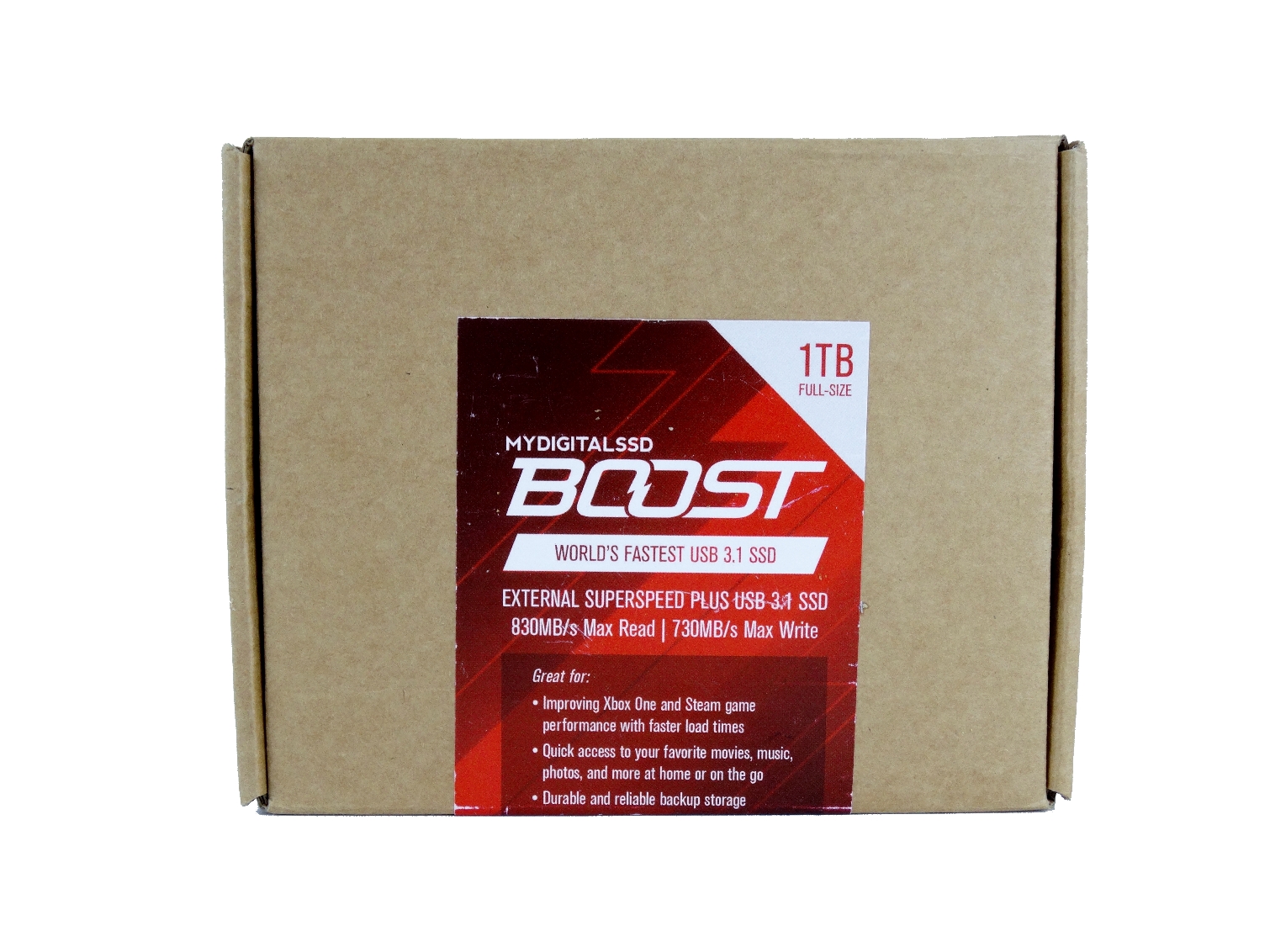
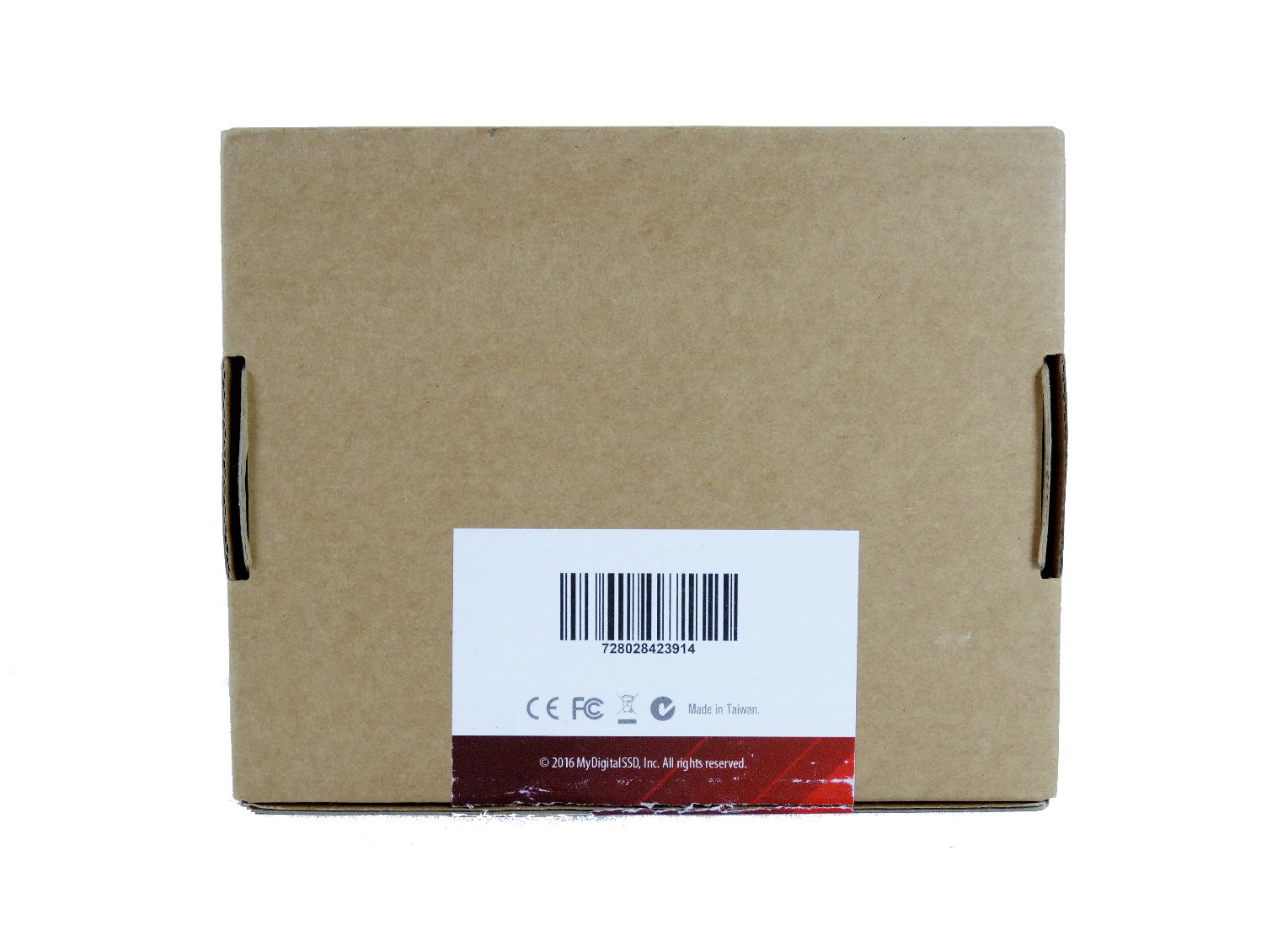

MyDigitalSSD already loaded our drive with two Samsung SSDs, so the screws were already in place. The DIY model ships with the screws and a small screwdriver in a bag. It includes everything you need except the drives.
A Closer Look
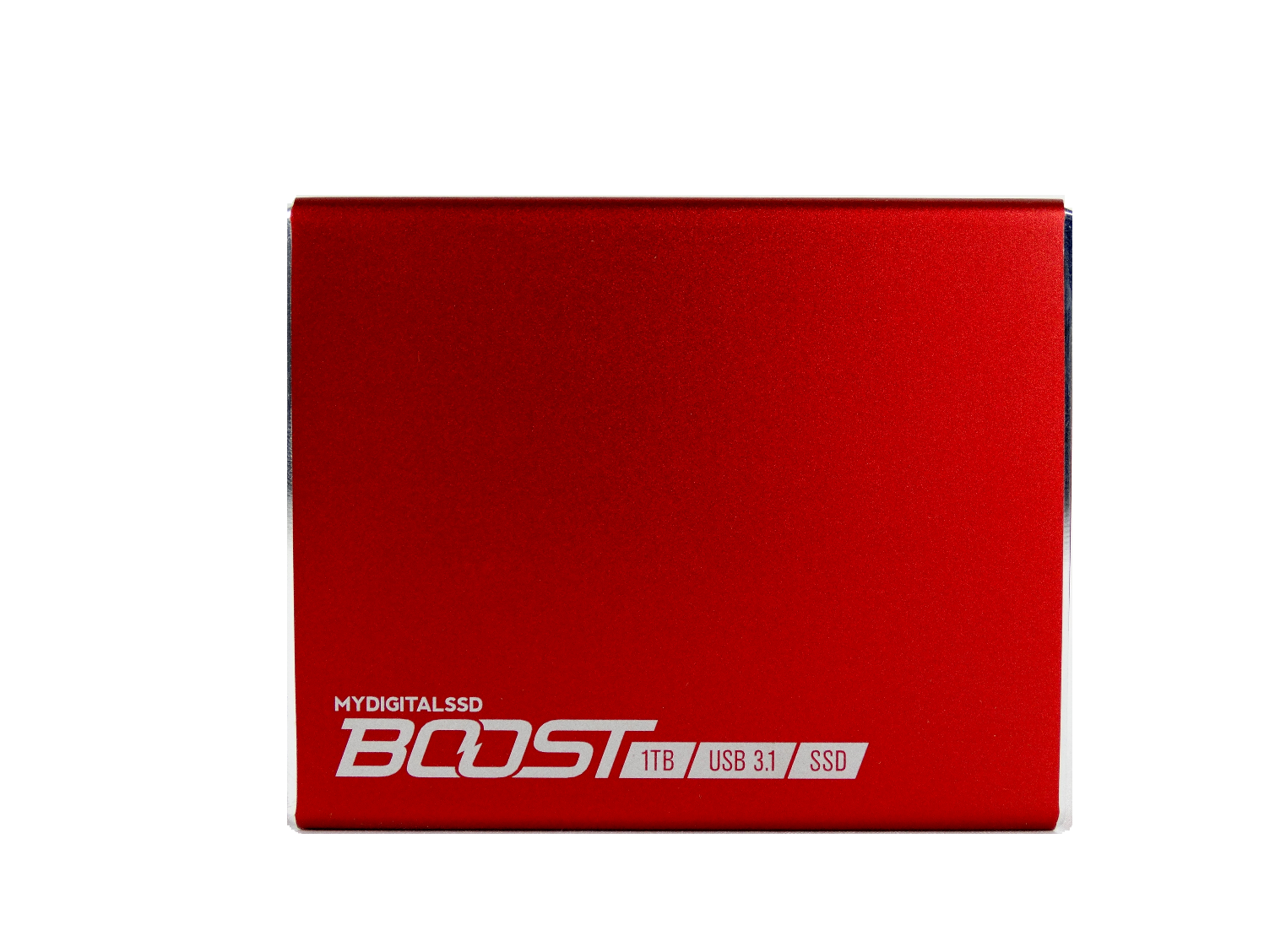
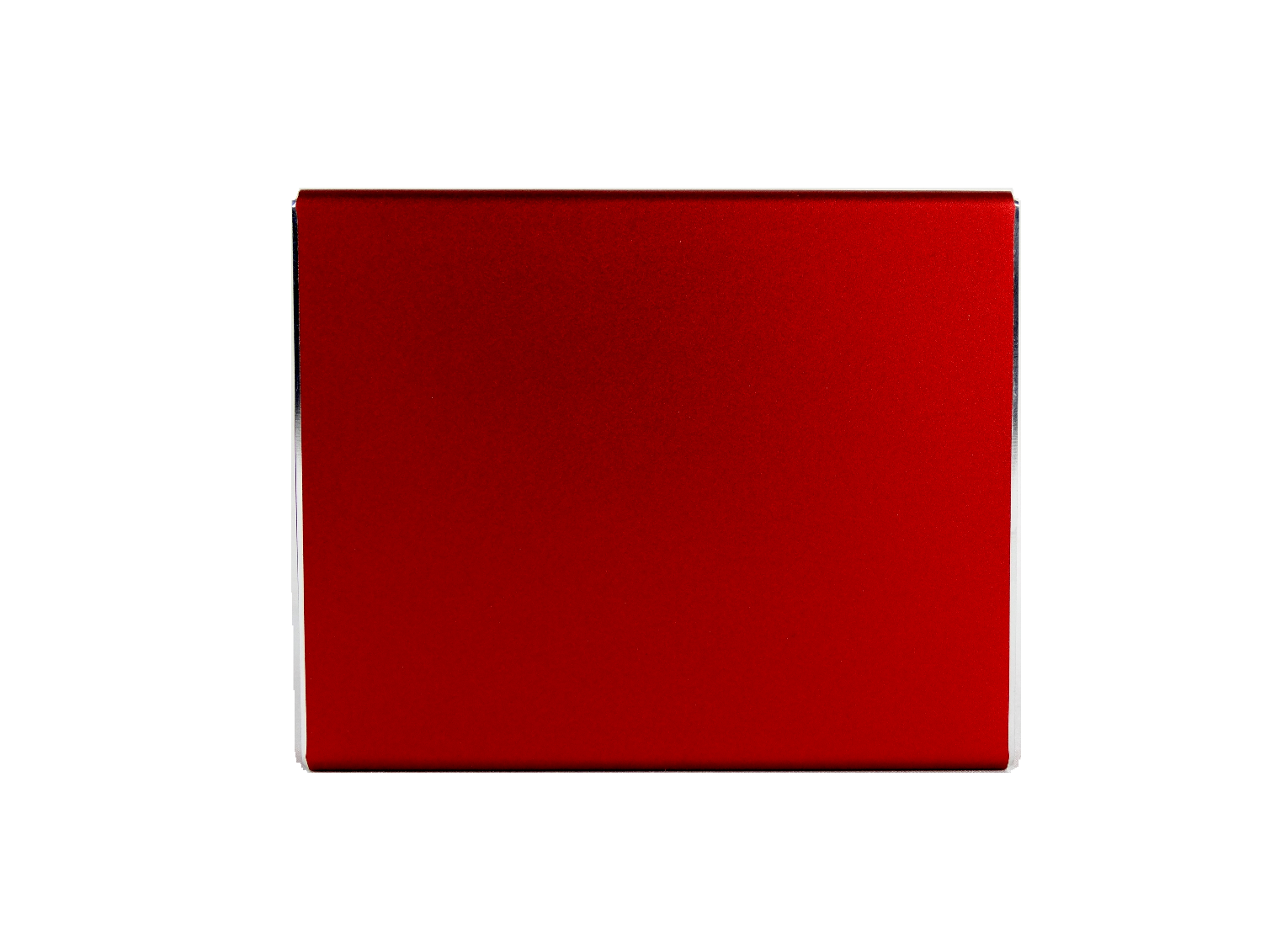
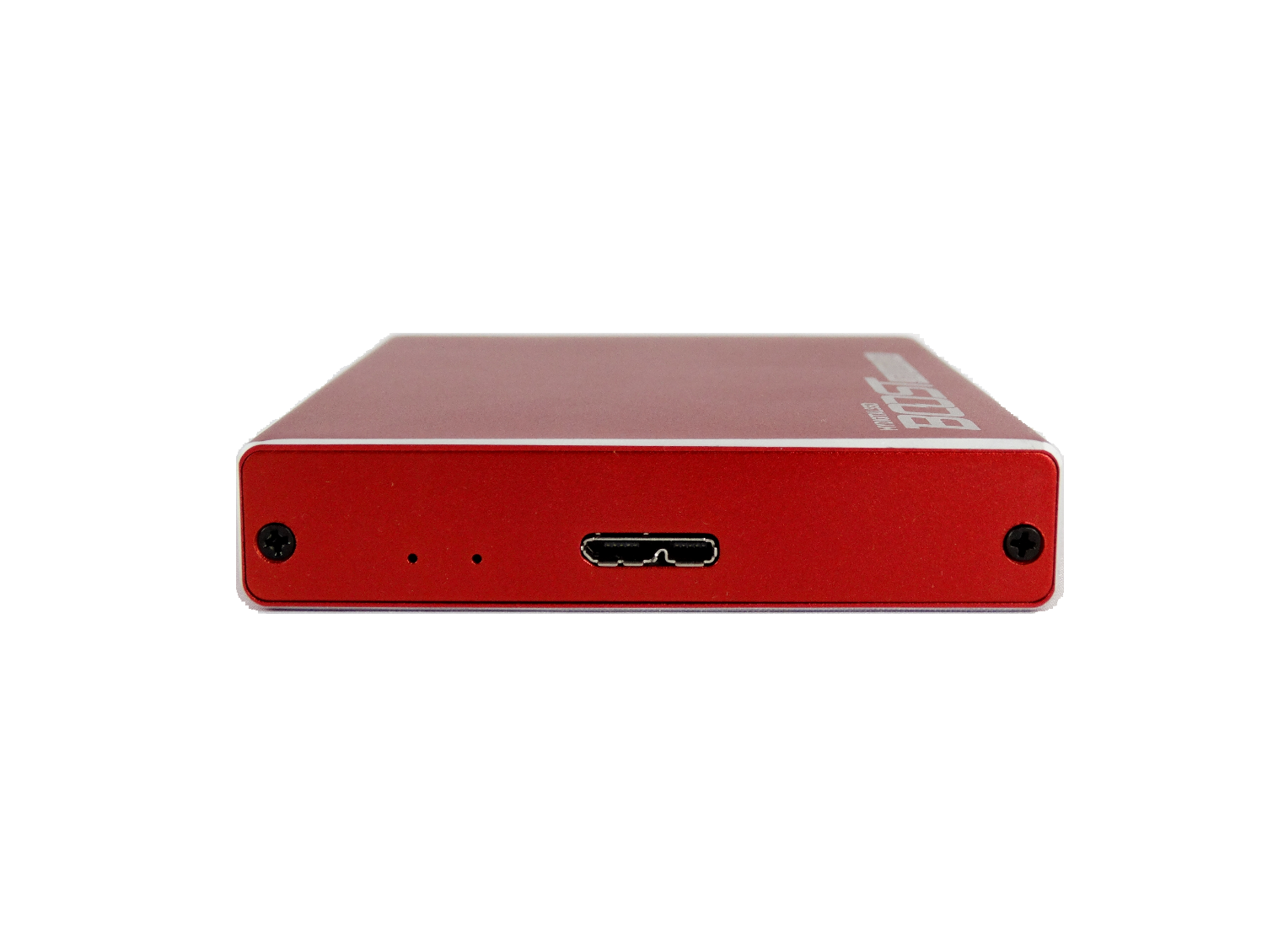
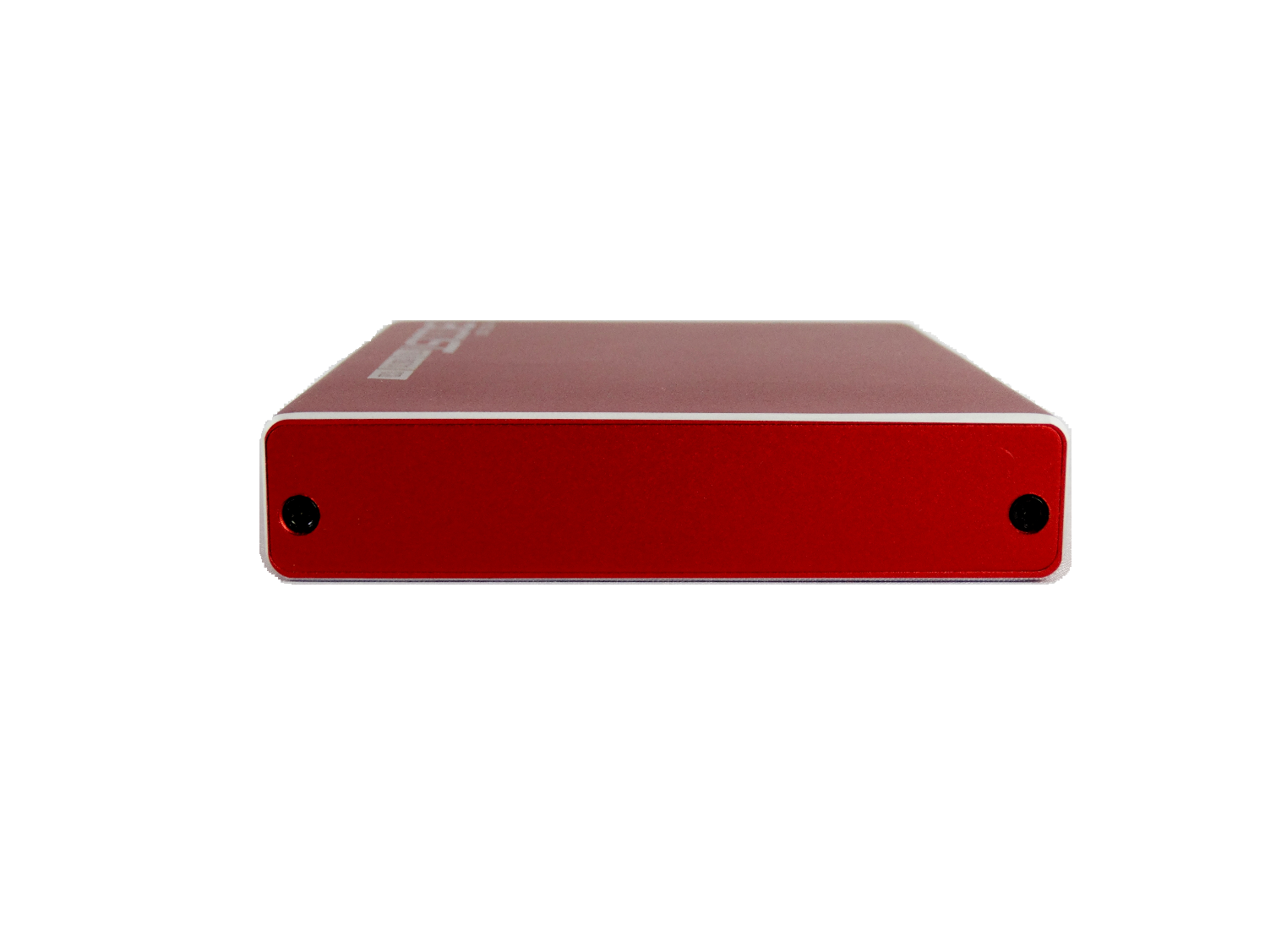
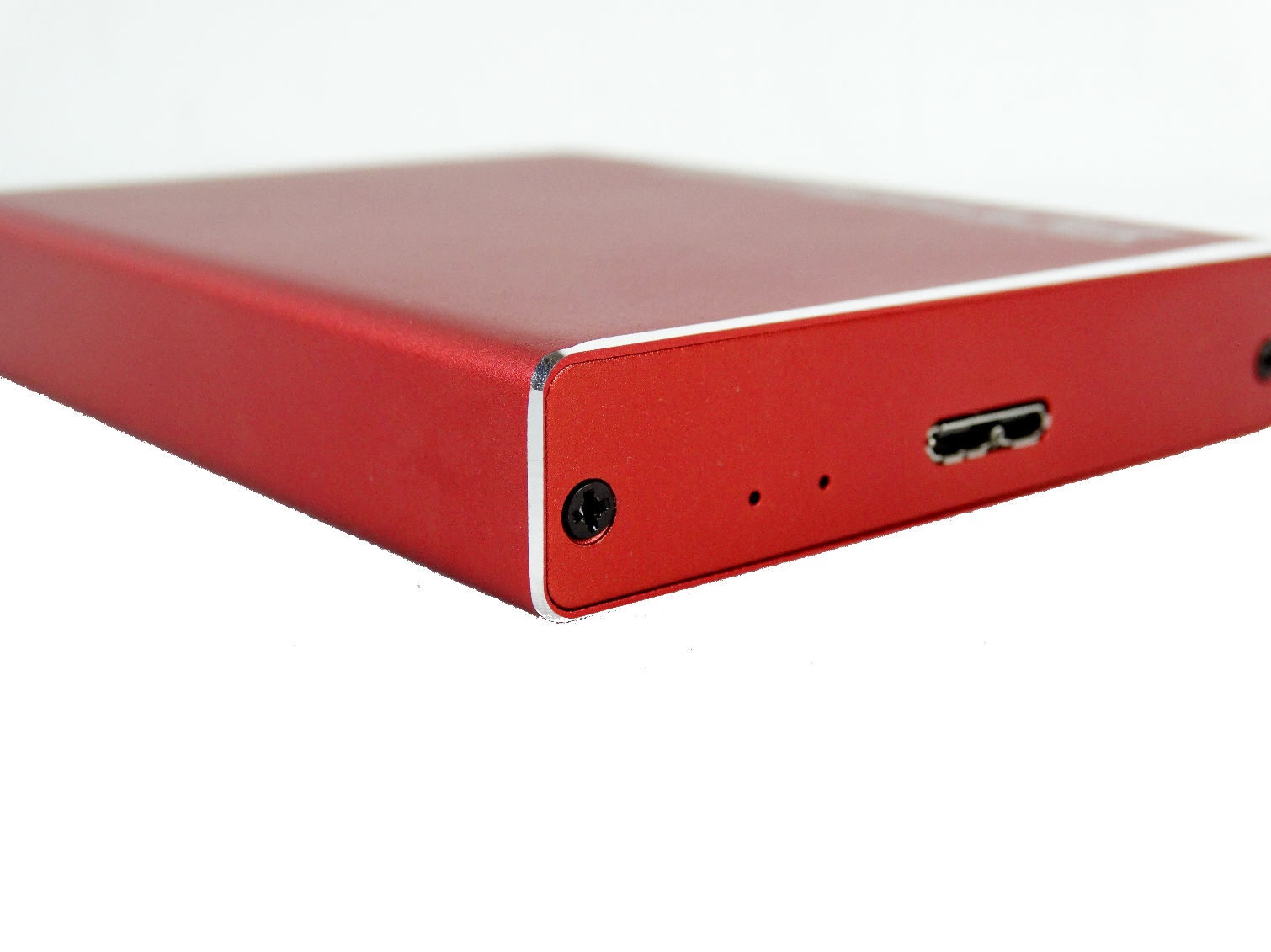
Portable SSDs fall into two distinct categories. The thin models are small enough to fit in a shirt pocket and look exciting, but usually offer low performance. Some are also comparatively fragile for a flash-based device. The second category is a little larger, features stronger enclosures and often increased performance.
An Inside Job
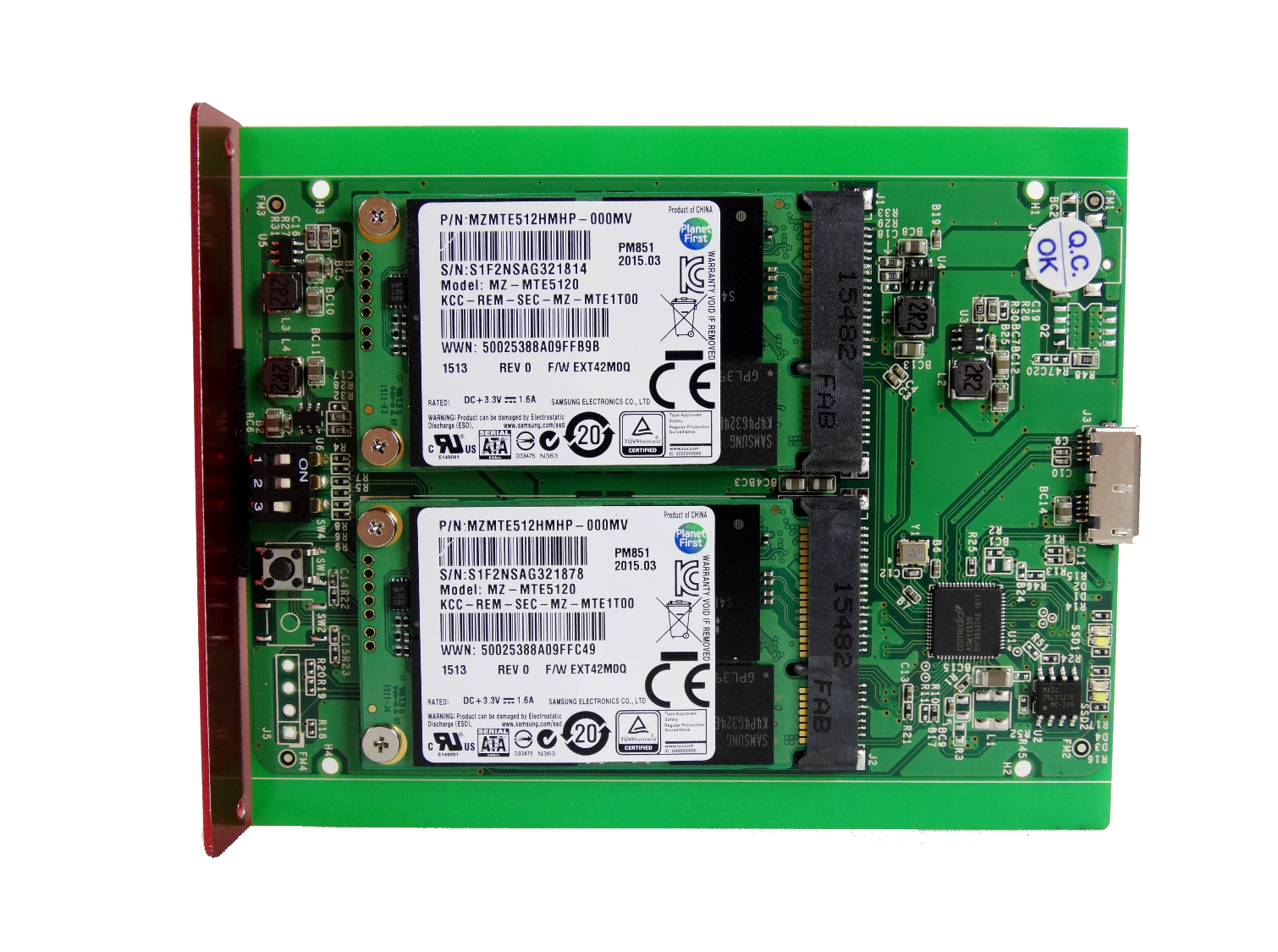
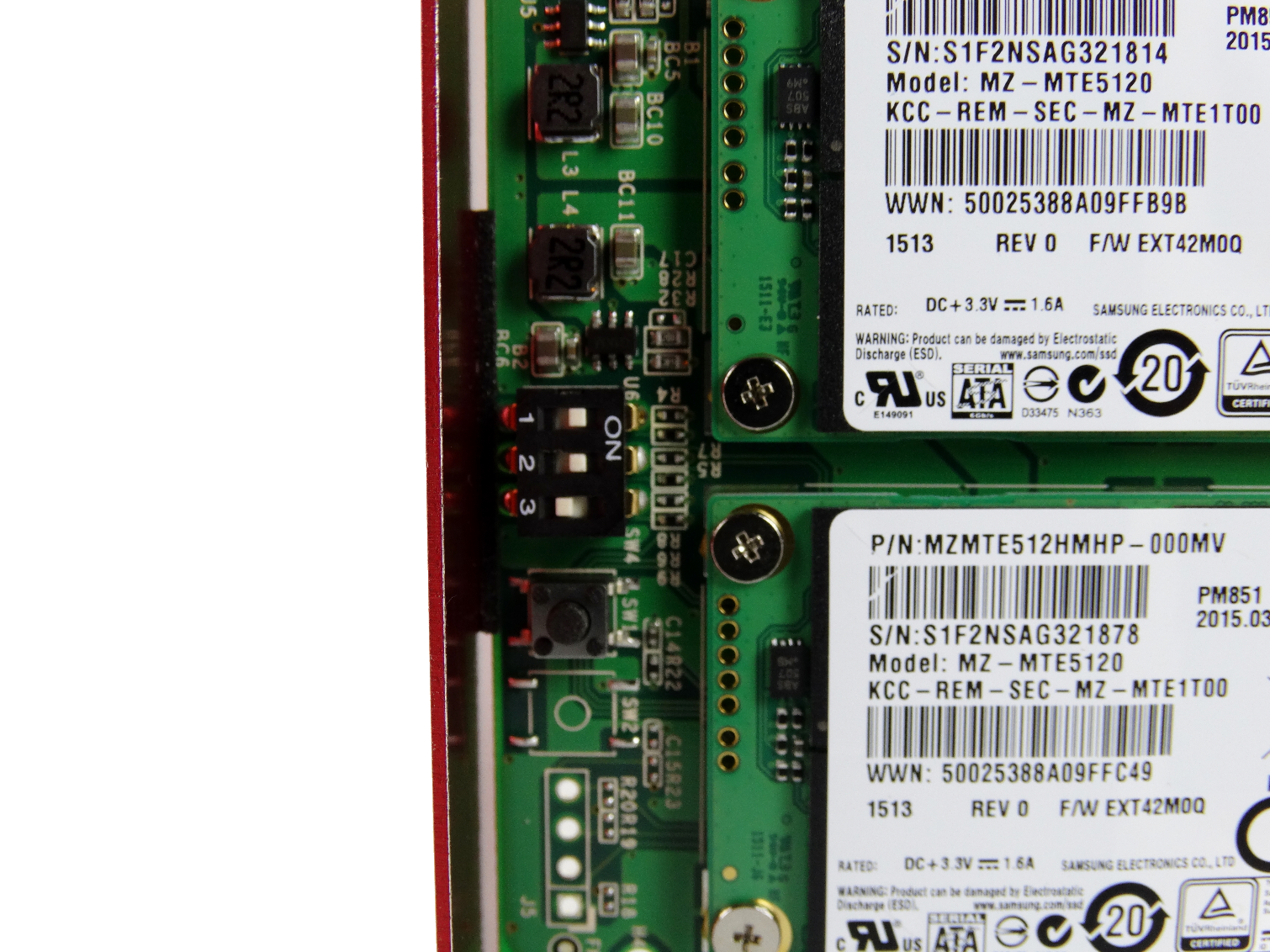
The enclosure invites us to peek inside. Two screws on either side provide access to the internals. A user-configurable DIP switch on one end allows you to change the RAID configuration. We left our drive in RAID 0 to take advantage of the advanced Asmedia USB-to-SATA RAID controller and utilize the full 10Gbps bandwidth.
MORE: Best SSDs
MORE: How We Test HDDs And SSDs
MORE: All SSD Content

Chris Ramseyer was a senior contributing editor for Tom's Hardware. He tested and reviewed consumer storage.
-
derekullo So with sata3 devices capping at about 540 megabytes a second for the read from the high end samsung ssds, Samsung 850 Pro, and from what I'm reading usb3.1 also uses 8b/10b encoding like sata does, could we say a fully saturated hypothetical 12 gigabit link would be 540x2 or 1080 megabytes a second?Reply
If that is true then to get a fully saturated 10 gigabit link we would go 1080 x 0.8 or 864 megabytes a second.
Would 864 megabytes a second be the upper limit for usb 3.1 ?
Edit: I'm blaming my calculator for those last 2 posts lol. -
HERETIC-1 Hi Chris,Reply
As to "not being used as a boot drive"
You'd be surprised how many mac users with a dead HD,that don't want
to pay the apple tax and boot from a external SSD.
Is that flash 840ish or more 750ish? (not that there's probably much difference) -
ttt_2017 Total rubbish product ... where is the NVME PCIe to USB 3.1 Bridge chip ?Reply
we dont need Raid , we have Blazing Fast NVME SSD already. we can Saturate the USB3.1 without the need of any Raid setup ... -
derekullo The question is, is this indeed saturating 3.1 like the article says?Reply
"We left our drive in RAID 0 to take advantage of the advanced Asmedia USB-to-SATA RAID controller and utilize the full 10Gbps bandwidth."
My math is showing they aren't, about 30 megabytes short of what 2 Samsung 850 Pros would do.
Although my math has been wrong before.
That's still respectable, but is 830 where the line is or is it 864. -
Xajel This is the cheapest 1TB I knew, the thing is.. it's even cheaper than buying those individual 500GB Samsung mSATA from Amazon. I know the parts here are different than the retail ones in Amazon... but it's really a good deal. It's funny as I was thinking about buying two mSATA for my old laptop and desktop to speed them up and was thinking about two 500GB from samsung too, as of why mSATA.. as I'll get rid of these two systems after 1-2 years so I'll get those two mSATA's and I'll use one as external fast storage and the second as a second OS boot image for my main PCReply -
CRamseyer If it published with "upper limit" then it's a writer to editor thing. My meaning was actually "upper limits" as in the upper limits of USB 3.1. Not the specific upper limit but the general, "this thing is fast", meaning.Reply
With 10Gb/s Ethernet (10GbE) I get slightly over 1000 MB/s of real data transfer with large files.
ASMedia will not have a USB to PCIe bridge that supports NVMe for several months. It will increase the cost of both the drive and the bridge chip so be careful what you wish for. I know of at least one company that has displayed a prototype but it was more of a shell mock-up rather than a working product. I suspect we may see early USB 3.1 to NVMe designs at Computex in June but don't expect any meaningful availability until CES in January 2018. -
derekullo Thanks for the response CRamseyer.Reply
830 megabytes a second is plenty fast for most everyone for consumer use and probably for the majority of small business use.
An increase in speed of 30 gigabytes a second won't matter anyway even if i did end up replacing the drives with Samsung 850 pros.
I was just trying to confirm that my math was correct and that 863 MB/s was the limit for usb 3.1, although if 830 MB/s is the limit that is perfectly acceptable too.
I was actually thinking about something similar to this a few weeks ago of putting the zil for my nas4free server on a super fast usb device/enclosure using ssds.
All the posts saying don't use usb are for like usb 2.0 flash drives.
Super fast. Check
1 Terabyte capacity. Check
Replaceable drives allowing for configurable write endurance/speed
Doesn't use a valuable sata port. Check
(This is probably the biggest plus, lets me add another 8 terabyte drive)
(Storage Density FTW)
It almost sounds too good to be true.
I'm unsure what the write endurance for the 500 gigabyte drives they include are, but worst case I would buy 2 - Samsung 850 Pros.
I would of course test all of this on a temp first.
If all of this works as planned i may even try to use a device similar to this for actual storage for my nas4free.
The 255 limit of usb devices on a single hub came to mind almost instantly.
But that is a topic for a much later date.
Thanks again. -
ttt_2017 Reply19322570 said:If it published with "upper limit" then it's a writer to editor thing. My meaning was actually "upper limits" as in the upper limits of USB 3.1. Not the specific upper limit but the general, "this thing is fast", meaning.
With 10Gb/s Ethernet (10GbE) I get slightly over 1000 MB/s of real data transfer with large files.
ASMedia will not have a USB to PCIe bridge that supports NVMe for several months. It will increase the cost of both the drive and the bridge chip so be careful what you wish for. I know of at least one company that has displayed a prototype but it was more of a shell mock-up rather than a working product. I suspect we may see early USB 3.1 to NVMe designs at Computex in June but don't expect any meaningful availability until CES in January 2018.
Intel USB3.1 controller can reach 20Gb/s per port (double Asmedia bandwidth) and currently only Gigabyte are releasing Motherboards with Intel USB 3.1 chipset.
we Can use NVME SSD on USB3.1 and get 2000MB/s sequential read/write if some one makes an NVME/USB3.1 Bridge.
More over , Companies are ignoring Thunderbolt 3 enclosures as well which can reach 4000MB/s
They will sell it overpriced I know but not because they are more expensive to make ,no because they target the 3D Rendering and movie editing companies. -
derekullo Instead of a thuderbolt enclosure I would make a zfs server with an i7 and 128 gigabytes of ram and 8+ sata ports stuffed with ssds on 40Gb ethernet or 50Gb Infiniband(Soon).Reply
Any reads from the device hopefully are pulled from the ARC (ram) which should allow you to cap out the 40Gb-50Gb connection or at least move the bottleneck to the user's computer.
No need for an L2ARC using all ssds.
I don't see a need for an ZIL since even if you were to use 8 ssds in a raid 10 even the write speed would be at least equal to the write speed of a Samsung 960 pro (about 2 gigabytes a second). Unless you needed an insane amount of write cache in which case you could use 2 Samsung Pro in a raid 0, which might be the case if you were recording at 8k or higher.
I mean that is what I would use if I were James Cameron instead of a thunderbolt enclosure.
If you think this looks impressive just imagine the backup system you would need to be able to handle the throughput for it lol.
If you haven't noticed.
I like zfs.
